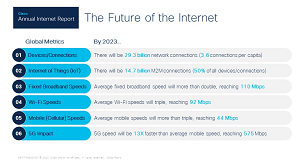News
5G Mobile Tech Highlights Cisco Internet Report
Blazing mobile connectivity speeds provided by next-gen 5G technology -- up to 13x more than today's average -- are highlighted in Cisco's big new Annual Internet Report, which also warns of bigger and more frequent distributed denial-of-service (DDoS) attacks.
"The average 5G speed will be 575 megabits per second, or 13 times faster than the average mobile connection," Cisco said in announcing its first annual report. "With advanced performance capabilities, 5G will deliver more dynamic mobile infrastructures for AI and emerging IoT applications including autonomous cars, smart cities, connected health, immersive video and more."
The study covers 2018-2023, assessing digital transformation across multiple business segments, such as enterprise, SMBs, etc., with a focus on fixed broadband and mobile networking. While fixed broadband tech -- Ethernet and Wi-Fi -- is more mature and stable, Cisco predicts big things for 5G mobile.
"The average 5G speed will be 575 megabits per second, or 13 times faster than the average mobile connection," Cisco said in announcing its first annual report. "With advanced performance capabilities, 5G will deliver more dynamic mobile infrastructures for AI and emerging IoT applications including autonomous cars, smart cities, connected health, immersive video and more."
Other 5G-related highlights of the huge report include:
- 5G devices and connections will be over 10 percent of global mobile devices and connections by 2023. By 2023, global mobile devices will grow from 8.8 billion in 2018 to 13.1 billion by 2023 – 1.4 billion of those will be 5G capable.
- 5G will further enable new IoT applications with extended reach and faster speeds. Applications that require greater bandwidth and lower latencies will have an access technology that allows them to flourish and nurture new innovations that were not previously possible with 4G technology.
- Wi-Fi6 will serve as a necessary complement to 5G. A significant portion of cellular traffic is offloaded to Wi-Fi networks to prevent congestion and degraded performance of cellular networks (due to demand). Public Wi-Fi enhancements will enable new partnerships and applications in hospitality/travel, healthcare, stadium venues, retail, and a host of other business verticals (for personal devices and IoT connections).
- 5G connections will appear on the scene in 2019 and will grow over 100-fold from about 13 million in 2019 to 1.4 billion by 2023. 5G connectivity is emerging from nascency to a strong contender for mobile connectivity driven by mobile IoT growth. By 2023, there will be 11 percent devices and connections with 5G capability.
 [Click on image for larger view.] Cisco Annual Internet Report (source: Cisco).
[Click on image for larger view.] Cisco Annual Internet Report (source: Cisco).
The nascent 5G rollout was also the subject of Cisco's December 2019 "2020 Global Networking Trends Report," in which the company said, "Eventually, having even more pervasive, high-speed, secure wireless connectivity will open up new kinds of business opportunities in all industries, from healthcare to transportation. In combination with the improved performance of both Wi-Fi 6 and (eventually) 5G, we are in for a large – and long-lived – period of innovation in access networking."
However, those access networking innovations mainly focus on speed, as opposed to security, which is also addressed in the report that focuses on DDoS attacks, which increased dramatically over the past year.
In listing global cybersecurity trends from 2018 to 2019, Cisco noted:
- Globally, the frequency of DDoS attacks increased by 39 percent.
- Globally, the peak attack size increased 63 percent.
- The average DDoS attack size is 1 Gbps (23 percent of attacks are greater than 1 Gbps); there has been 776 percent growth in attacks between 100 Gbps and 400 Gbps.
In a blog post this week (Feb. 18), Cisco's Thomas Barnett, Jr. also addressed security. "Expansion and growth will also require new cybersecurity measures to prevent and mitigate risk," he said. "More devices and connections that are supported with more scalable networks and cloud computing provide new targets for nefarious activity. The good news is that artificial intelligence and machine learning can serve as powerful tools to automate security and detect intrusions before they become problematic or catastrophic."
About the Author
David Ramel is an editor and writer at Converge 360.